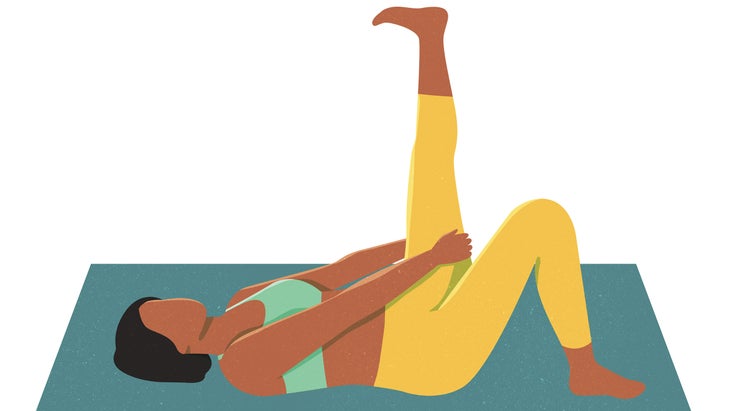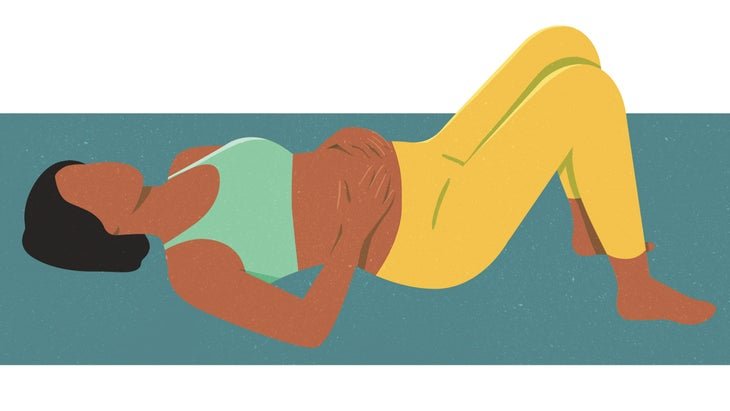“], “filter”: { “nextExceptions”: “img, blockquote, div”, “nextContainsExceptions”: “img, blockquote, a.btn, a.o-button”} }”>
Every pregnancy is different for every person. While you may experience joy and excitement at the thought of bringing new life into the world, you can also confront feelings of fear, doubt, and worry about all the changes to come—within your body and your life, especially early on in the pregnancy.
Corinne Andrews knows this all too well. As a Massachusetts-based prenatal and postnatal yoga instructor and mother of two, Andrews has worked with expectant parents for years. Her in-person and online yoga and wellness program, called Birthing Mama, was created as way to support parents in experiencing pregnancy as a “sacred and holistic life event and as a pathway to awakening.”
Now, her course has been adapted and expanded upon in an upcoming book: Birthing Mama: Your Companion for a Wholistic Pregnancy Journey includes week-by-week reflections, yoga, wellness recipes, journal prompts, and more to guide expectant parents through the ups and downs of pregnancy and the postpartum period. Here, Andrews shares an excerpt on how to honor and nurture yourself during the first trimester.
Also from Birthing Mama:
3 Grounding Practices for the Second Trimester of Pregnancy
The Great Wait: How to Stay Centered During the Third Trimester of Pregnancy
3 Yogic Practices to Help Prepare for Labor & the Fourth Trimester
Yoga: Focus on resting
You will have plenty of time to do strengthening practices throughout your pregnancy, but if you are aren’t feeling well, please remember that you are growing a human being inside your body and an incredible amount is happening in this first trimester. The most important practice is to rest deeply. Try this simple practice that feels just as good to do in your bed as on the yoga mat!
Lie on your back with an optional pillow, folded towel, or blanket under your head. Bend your knees, and place your feet on the floor a little wider than hip-width apart.

Inhale with your legs in the center. Then, as you exhale, roll your pelvic halves and legs to the right.
Yield and push your feet into the earth. Inhale and roll up to center again, then exhale and roll your legs to the left. Move back and forth like this for 3 to 10 rounds. You can also hold the simple twist to each side for a few breaths.

Bring your knees back up to center. Place your feet only as wide as your hip joints, and interlace your fingers behind your right thigh. Yield and push your hands and thigh into each other (this stabilizes the sacroiliac joint), reaching the ball of your right foot up toward the sky and straightening your leg. Relax your shoulders and take 3 to 10 breaths. Then switch and do the same with your left leg.

Now bring the soles of your feet together, heels close to your pelvic floor, and allow your knees to open (you can also place blocks under your thighs). Using the palms of your hands, make slow downward strokes along your body from your face down to the bottom of your pelvis or even upper legs if you can reach there easily. With each downward stroke, exhale a very long breath and imagine your anxiety, fear, or nausea flowing and releasing down and out of your body. Enjoy for one to three minutes.
Tip: You can ask someone else to do this same downward stroke for you (on your back if you are sitting upright) in harmony with your exhalations. Receiving this loving touch can be very helpful, especially if you find yourself dry heaving or vomiting.
Relax with Relaxin
Relaxin is a hormone that softens, loosens, and relaxes your joints and ligaments. The level rises during the first trimester and peaks around the fourteenth week. Everything is conspiring to make room for your uterus to expand, so you may already begin to experience backaches.
For those who tend to be very flexible, pregnancy is not the time to ride on the relaxin and test the limits of your increased flexibility. This can lead to pain or injury. Keep this in mind through the rest of your pregnancy and in the postpartum phase, when it’s time to knit your body back together again.
See also: Which Yoga Poses are OK for First Trimester?
Reflect: What nourishes you?
The first trimester is a great time to zoom out and look at the overall picture of your health and well-being. Aim to learn what truly nourishes you and not just what you think nourishes you based on the past or based on what society told you would nourish you. Read through the following suggestions and feel what resonates with you.
- How you spend your time matters. You matter, your life matters. Make conscious choices about how you spend your time and energy.
- When possible, eat fresh, organic, local, and easily digestible foods. Be sure to incorporate healthy fats, oils, and proteins into your diet as well as fresh veggies, fruits, and whole grains.
- Surround yourself with positive, light-filled people, music, books, shows, movies, and work. Choose to have a boundary that says no to taking in outside energies of fear, anxiety, and anger.
- Commit to a time every day that you will go to your pregnancy altar (see page 28) and sit for 5 to 30 minutes. Simply witness yourself breathing. See the mantra meditation on page 24 for help with a busy mind.
- Consider prayer. Prayer may feel like a loaded word, but you can think of it as a simple calling out from your deepest self to whatever greater spirit you connect to. Prayer is unique to each being, a beautiful way to join matter and spirit and feel connected to the essence that created you and that holds us all as we go forward day by day.
- Talk to wise women in your life who have walked this path before you—be they sisters, friends, mothers, or grandmothers. Let your heart and mind become full with their empowering stories.
- Find time to go into nature as often as possible—take a gentle stroll, a vigorous hike, a swim, or simply sit. Wherever you live, take a walk every day!
- Aim to get in bed around 9:00 p.m. with lights out by 10:00 at the latest. Create a screen- and device-free space for yourself starting at 8:00 p.m. Sleep in a dark room with as little electronic energy as possible.
Create: How to build a pregnancy altar

Create a pregnancy altar that you can come to anytime you want to meditate, relax, pray, journal, or be creative and connect with yourself and your growing baby. You can use this sacred space throughout your pregnancy and birthing time, and even later as a postpartum and forever-mama altar space. It doesn’t have to be a large area. It can include anything and look like anything as long as it feels perfect for you.
- Choose the right place in your home to create this altar. Make sure it is large enough to fit a cushion for you to sit or lie on. This is also a nice place to keep your yoga mat.
- Find a small table, bench, or even an empty cardboard box to serve as the altar base. It is nice to position the altar against a wall so you can hang photos around it.
- Cover the altar base with a beautiful cloth, paint it, or leave it as is.
- Find objects that inspire you, and arrange them on the altar so that they are always there for you when you are looking for connection.
- Remember that your altar can change and grow as you need it to. Nothing on it is set in stone.
Ideas for your altar
- Objects found in nature
- Photos of nature, places, or people that uplift you
- Stones and crystals
- One or more candles
- Small inspirational books, prayers, quotes, poems, or a deck of tarot cards
- Figures or statues of deities or angels
- Anything related to pregnancy, birth, and motherhood that inspires you
See also:
A Prenatal Practice to Relieve Pain & Enhance Mobility
A Prenatal Sequence to Worry Less & Trust More
6 Yoga Poses to Strengthen the Pelvic Floor During Pregnancy
Excerpted from Birthing Mama© by 2021 Corinne Andrews. Used with permission from Storey Publishing. Find Birthing Mama prenatal yoga and wellness videos at Wellmode.
Liked this article? Join Outside+ and get unlimited access to exclusive articles, sequences, meditations and live experiences—as well as thousands of healthy recipes and meal plans from Clean Eating and Vegetarian Times, plus can’t-miss content from more than 35 other brand like Women’s Running, Backpacker, and Better Nutrition.

